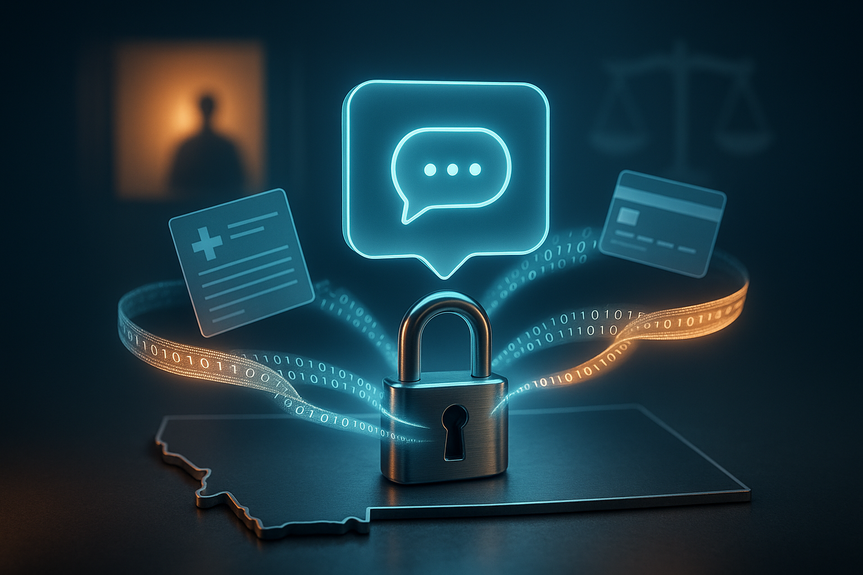
AI News
10 Nov 2025
Read 15 min
Morocco AI dark web data monitoring How to stop leaks
Morocco AI dark web data monitoring lets CNDP detect leaks fast and compel data controllers to act
Morocco AI dark web data monitoring: What CNDP is doing
Automatic scanning and alerts
The CNDP will use AI systems to scan the dark web and other hard-to-reach corners of the internet. The dark web is a set of sites that run on special networks like Tor. These sites hide the server and the visitor. Criminal forums and markets often sit there. The AI looks for patterns that match personal data. It can match emails, ID formats, or leaked files. When the system finds a hit, it sends an alert. The alert helps the CNDP and the affected organization act fast to limit harm.Legal follow-up under Law 09-08
Morocco’s Law 09-08 sets rules for personal data processing. The law requires many controllers to register their processing with the CNDP. If data appears online and the controller did not register, the CNDP can push legal steps. Even when a controller is registered, the CNDP can still require fixes and checks. The goal is to protect people and to make sure processing stays lawful, secure, and fair.Why this matters for businesses and citizens
Better monitoring reduces the time that stolen data stays in the wild. That lowers fraud and identity theft. It also helps companies see weak spots faster. Early alerts give teams a chance to reset passwords, cut stolen keys, and warn users before damage spreads. For citizens, that means fewer surprises and stronger rights. For companies, it means stronger trust and fewer costs.How leaks start: common paths attackers use
Attackers do not need a zero-day to steal data. They use simple, repeatable methods. Know these paths and close them.- Phishing: Fake emails or messages trick staff into sharing passwords or running malware.
- Credential stuffing: Attackers try leaked passwords from one site on your systems.
- Misconfigured cloud: Open storage buckets or weak access rules expose files to the internet.
- Third-party risk: A vendor with weak security becomes the backdoor to your data.
- Exposed databases: Test servers or old backups left without passwords get indexed.
- Insider mistakes: A staff member sends a file to the wrong person or uploads it to public tools.
- Malware on endpoints: Infected laptops grab browser-stored passwords and session tokens.
Stop leaks before they spread
Know your data and systems
You cannot protect what you cannot see. Build a living map of your data, apps, and vendors.- List where you store personal data, why you need it, and who can access it.
- Tag sensitive fields like ID numbers, health data, and financial data.
- Track data flows between systems and to third parties.
- Remove unknown or orphaned servers and storage.
Reduce what you store
Less data means less risk.- Collect only what you need for a clear purpose.
- Set retention rules and delete old records on a schedule.
- Use tokenization or partial masking when full data is not required.
Protect access
Most breaches start with a stolen login. Make logins hard to steal and useless when stolen.- Use multi-factor authentication everywhere, favor passkeys where possible.
- Adopt least privilege. Give access only to the data needed for the job.
- Rotate and vault secrets. Do not store API keys or passwords in code or chat tools.
- Enable device checks. Block access from unmanaged or risky devices.
Secure the cloud and endpoints
Your laptops and your cloud control plane are prime targets.- Turn on disk encryption on all devices. Enforce strong screen locks.
- Patch systems fast. Automate updates for browsers and plugins.
- Use endpoint protection (EDR/XDR) to catch malware and data grabs.
- Run cloud posture tools. Close public buckets and weak identity roles.
- Back up critical data. Test restores often.
Watch the outside: dark web and open sources
What you do inside your network is not enough. You need eyes on the outside.- Monitor paste sites, forums, and code repos for your domains and brands.
- Use canary data tags (honeytokens) to detect leaks early when they appear online.
- Pair internal controls with Morocco AI dark web data monitoring by trusted services and public bodies.
- Set clear runbooks for who receives alerts and how they respond within hours.
Respond fast when data appears online
For organizations
Speed saves you time, money, and trust. Prepare now so your first minute is not chaos.- Confirm the leak. Identify what data, how much, and the source system.
- Contain the issue. Disable exposed accounts, rotate keys, revoke tokens, and block malicious IPs.
- Preserve evidence. Capture logs and snapshots for forensics and legal steps.
- Notify leadership, legal, security, and privacy teams at once.
- Engage the CNDP where required by Law 09-08. Follow any directions you receive.
- Inform affected people with clear advice. Avoid blame. Share steps to stay safe.
- Fix the root cause. Patch, reconfigure, or strengthen vendor controls.
- Review your playbook after the incident. Update gaps and train again.
For individuals
If your data is exposed, act quickly.- Change passwords and move to passkeys where offered. Do not reuse passwords.
- Turn on multi-factor authentication on email, banking, and social accounts.
- Watch bank and mobile money accounts for strange charges.
- Replace exposed ID documents if recommended by authorities.
- Beware of phishing that uses your leaked data to look real.
Governance and compliance in Morocco
Register processing and keep records
Many types of personal data processing must be registered with the CNDP under Law 09-08. Keep records of your data activities. Update your entries when systems or purposes change. This shows accountability and helps during incidents.Consent and transparency
Tell people what data you collect, why you collect it, and how long you keep it. Get consent when the law requires it. Make it easy to withdraw consent. Publish a clear privacy notice and keep it current.Cross-border transfers
If you move data outside Morocco, check legal conditions. Use contracts and safeguards that protect the data. Keep track of where copies are stored. Review cloud regions and backup policies.Vendor contracts and audits
Vendors that handle personal data must meet your standards.- Write data protection terms into contracts.
- Assess vendors before onboarding and at set intervals.
- Require breach notice timelines and cooperation duties.
- Limit vendor access to only what they need to do their job.
Training and culture
People stop leaks every day. Make training short, real, and frequent.- Run phishing drills. Share what to do when someone clicks.
- Teach safe handling of files and documents.
- Explain how to report a suspected leak without fear.
AI strengths, limits, and ethical guardrails
AI can search large volumes of sites, languages, and formats. It can spot patterns that humans miss. It runs day and night and gets faster with feedback. But it has limits and risks that leaders must manage.- False positives: AI can flag harmless content. Keep a human in the loop to review alerts.
- Evasion: Criminals change formats or hide behind new tools. Update models often.
- Privacy during monitoring: Avoid scraping more than needed. Focus on threat indicators.
- Proportionality: Use the least intrusive method that still protects people.
- Transparency: Document how tools work, how you validate results, and how you fix errors.
- Local capacity: Train local teams to operate and improve systems over time.
Metrics that show progress
Track simple numbers that reflect real risk reduction.- Mean time to detect (MTTD): How long from leak to first alert.
- Mean time to respond (MTTR): How long from alert to containment.
- Exposure window: Time data stays publicly accessible before removal or mitigation.
- Encryption coverage: Percent of sensitive data encrypted at rest and in transit.
- Patch speed: Percent of critical patches applied within policy.
- Credential hygiene: Percent of users with MFA and passkeys. Rate of password reuse.
- Vendor coverage: Percent of high-risk vendors with recent assessments.
- Training effect: Phishing click rate and report rate over time.
Tools to consider
You do not need every tool. Pick the few that match your risks and size. Integrate them well and maintain them.- Identity and access management with MFA and conditional access.
- Secrets management and key rotation for apps and cloud.
- Endpoint detection and response on all devices.
- Cloud security posture management to fix misconfigurations.
- Data loss prevention for email, endpoints, and cloud storage.
- Security information and event management with automation for response.
- Dark web monitoring from trusted providers and public bodies.
FAQ
Contents






